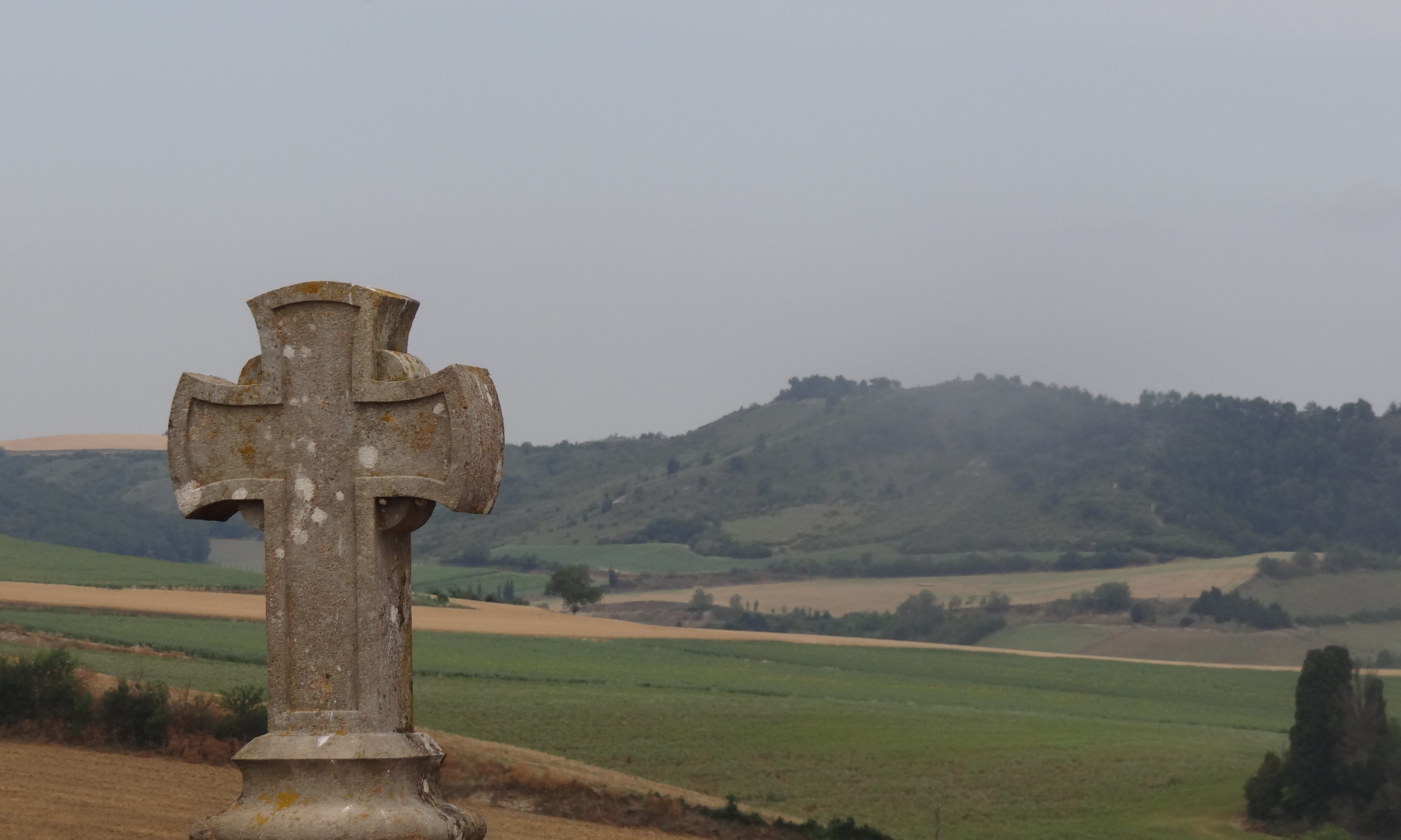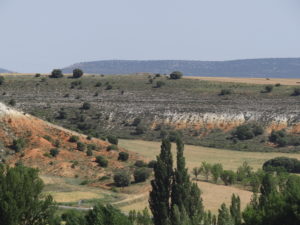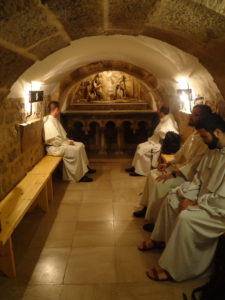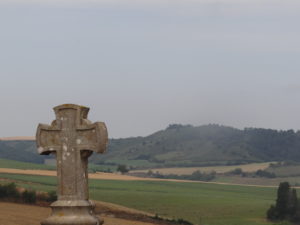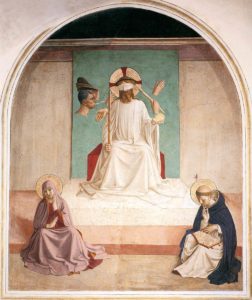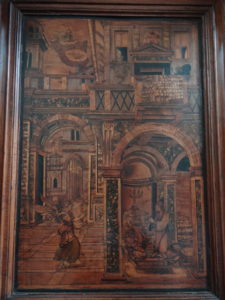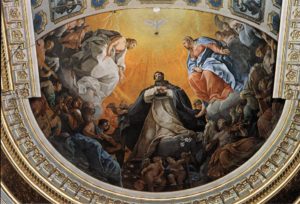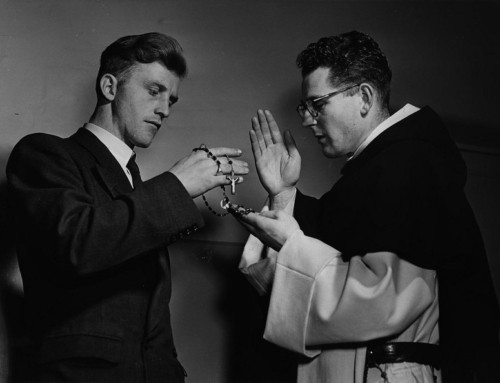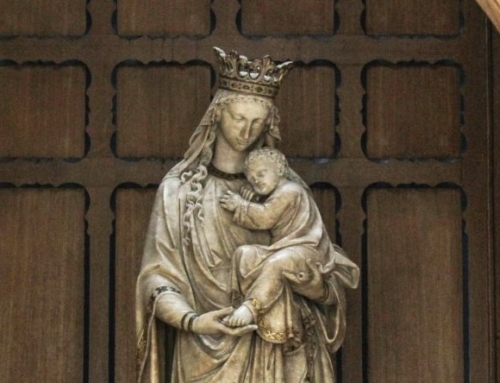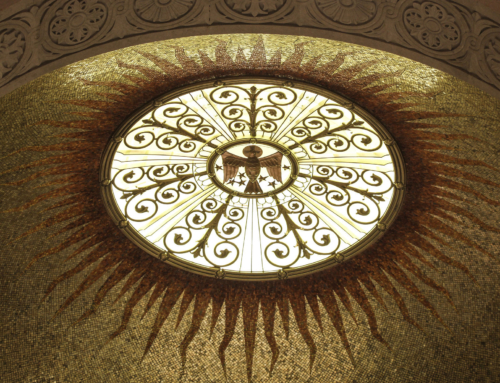During this past summer of 2016 I, along with over one hundred other brothers and sisters in formation, was able to join the Master of the Order, Fr. Bruno Cadoré, for a pilgrimage “In the Footsteps of St. Dominic” to celebrate the 800th Jubilee of the Order’s founding. Along the way we took in many of the major cities in Spain, France, and Italy where St. Dominic first sent his friars and also most of the small towns where the Order has its roots. The Order of Preachers has had a particularly strong association with cities since its founding. Rome, Paris, Toulouse, and Bologna are some prominent ones that figure heavily in the establishment and spread of the Order. Cities and their universities afforded the friars places to study the truth and a multitude of souls with whom to share that truth in their preaching. Though it is sometimes overlooked, the Order also has a certain connection with small towns and their surrounding rural areas. Our founder St. Dominic was born in a small village in Spain and did much of his early preaching in a few small towns in France. Visiting these places helped us to get a better sense of who St. Dominic was and of the order he founded. One of the facets of St. Dominic’s character that I frequently considered during the pilgrimage was his patience. I would like to share with you my reflections on the pilgrimage from that vantage point.
Rose of Patience
In the beautiful antiphon ‘O Lumen’ St. Dominic is called the “rose of patience.” This title, says Fr. Richard T. A. Murphy, O.P. , in The Timeless Dominic (Cluny Media, 2015), links two interesting ideas together: “the beauty of Dominic’s patience and the necessity and fact of his courage.” Patience is a part of the virtue of courage and enables one to endure an evil or sorrow that is present while also taking reasonable steps, if possible, to alleviate that evil or sorrow. Plenty of stories have come down to us from the life of St. Dominic that manifest the beauty and courage of his patience. The places of the pilgrimage told us these stories.
Dominic’s tiny hometown of Caleruega in Spain, which we visited during the first leg of the pilgrimage, explained to us in part how he came by his patience. A very quiet village located near the mountains in a tough, arid, but agricultural region, it is the type of setting that seems to naturally engender patience in its inhabitants. The area reminded me of the American Southwest in its aridity and red soil, but is a little greener and perhaps not quite as hot. M.-H. Vicaire, O. P., in his tome St. Dominic and His Times (Alt Publishing, 1964) characterizes the region as demanding relentless effort, courage, and heroism from those who made their living in it. That is, patience would also have been needed in dealing with the rugged conditions. All the many farmers and vineyard workers—Caleruega, as we discovered, is known for its particularly sweet variety of wine—would have had to painstakingly irrigate and nurture their crops. Perseverance and steadiness of purpose would be natural results of this way of life.
In addition to the demanding physical environment, Dominic’s family life also fostered patience. He belonged to the noble family of Caleruega, but they lived close to the people, sharing their way of life and helping them bear their hardships. Both of his parents were loved and revered in the town and surrounding country because of this. Their very modest castle deteriorated early on, we were told, when Dominic and his two brothers entered the priesthood, thus leaving the place unattended. Their memory, though, is still preserved in the monastery of Dominican nuns (and later an adjoining convent of friars) that soon replaced the castle. An arm bone of Dominic’s mother, Bl. Jane of Aza, is prominently displayed in the chapel and the bones of his father Felix and his brother Antonio are in a hallway leading down to the chapel’s crypt. Bl. Jane was particularly devoted to the poor and gave generously to them from the family’s possessions. A tiny oratory in the friars’ convent in what used to be the family’s cellar is the place of what is perhaps her most famous miracle. Bl. Jane had given away so much of the family’s wine on one occasion that it seemed there wouldn’t be enough for their own needs. Trusting and without fear, however, she returned to the cask and found it full.
The firm and steady perseverance of the people of Caleruega and the patient charity of his mother and other family members took deep root in St. Dominic’s soul and were revealed in his demeanor. Those who met him frequently noted his interior peace and exterior cheerfulness. Bl. Jordan of Saxony, for example, leaves us a description of Dominic in his Libellus (the common name for the text found in Jordan of Saxony: On the Beginnings of the Order of Preachers, Simon Tugwell ed. & trans. Parable, 1982) in which he characterizes Dominic as calm and constant, but also as sensitive to the needs and sufferings of those around him:
“His mind was always steady and calm, except when he was stirred by a feeling of compassion and mercy; and, since a happy heart makes for a cheerful face, the tranquil composure of the inner man was revealed outwardly by the kindliness and cheerfulness of his expression. He never allowed himself to become angry. In every reasonable purpose which his mind conceived, in accordance with God’s will, he maintained such constancy that he hardly ever, if ever, consented to change any plan which he had formulated with due deliberation.”
Proof of the accuracy of this description is also found in the Libellus in a famous story that illustrates the beauty of Dominic’s patience in his charity to the poor. It comes in the midst of his many years of quiet and persistent study as a young man. While he was at the university in Palencia there was a great famine. To alleviate the suffering around him, Dominic sold his books and gave away the proceeds. Bl. Jordan tells us that Dominic needed these books very badly, but he was willing to endure the hardship of parting with them for the sake of aiding those who were destitute. His patience seems to have extended even to the possibility of setting himself back in his studies. The beauty of that patience is in the balance that it allows him to maintain. He took the quest for truth very seriously, both for his own benefit and for the benefit of others. But he was not so enwrapped in it that he lost sight of his neighbor’s needs and the demands they placed on charity.
After seeing and hearing what Caleruega and a few other towns of Dominic’s early life had to tell, the pilgrimage moved into France. We stayed in the city of Toulouse where the first Dominican-built church still stands and today houses the relics of St. Thomas Aquinas. From Toulouse we made a day trip to the smaller cities of Fanjeaux, Prouille, and Carcassonne. Fanjeaux is set high on a hill overlooking the valley of beautiful farm country in which Prouille lies. Vineyards and fields of bright yellow sunflowers, wheat, and some corn cover the region. St. Dominic spent ten years preaching to the Albigensians in this area before he formally established the Order. They were years of long, hard labor in which he met with relatively little success. But his patient resolve did not waver in the midst of the many trials he encountered.
There is an old path through the farm fields connecting Fanjeaux to Prouille which St. Dominic traveled often. He would go from Fanjeaux, where he lived with a few companions, down to Prouille to visit the monastery of nuns he had established. After touring Fanjeaux, we ourselves traveled that path to visit the nuns who live in Prouille today. Along the way we visited the spot that commemorated the most dumbfounding and courageous story of Dominic’s patience. The “Assassin’s Cross” there recalls that once some heretics had planned to take his life as he was traveling the route. Bl. Jordan recounts that Dominic suspected the place where they were waiting for him but boldly continued right past it, singing to himself. For one reason or another the assassins did not strike. Later, the heretics, who were amazed at his “imperturbable firmness,” asked him why he had no fear and what he would have done if they had taken him prisoner. Revealing just how deep his patience could go, Dominic answered them, “I should have asked you not to strike me down quickly and kill me all at once, but to prolong my martyrdom by mutilating my limbs one by one, and then to display the mangled bits of my body before my eyes, and then to gouge out my eyes and either leave what remained of my body wallowing in its own blood or finish me off completely; a slow martyrdom like that would win me a much finer crown.” It might seem to be quite a macabre response, but it shows that St. Dominic lived with his eyes set on the heavenly city and on the Lord. He was willing to endure martyrdom, even a slow, painful one in order to arrive there sooner. He understood how much Jesus had lovingly suffered for him, and he wanted to be conformed to that love to as great a degree as possible.
One of the moments of strongest appreciation for St. Dominic’s patience hit me as we travelled by bus from Toulouse into Italy to visit the cities of Siena, Rome, Florence, and Bologna. It would have been a long ride in any case, but was made hours longer by the heavy traffic of the opening day of the European vacation season. The thought occurred to me that, for the last several years of his life, St. Dominic was almost constantly journeying on foot between all these places, through mountains, across rivers, and in all kinds of weather. The hardships he endured would have been immense, and yet his companions reported him to have been always cheerful.
Patience in Prayer
In the Italian cities, we visited several Dominican churches and convents. In Rome we saw the convent of San Sisto, the original Italian convent of the friars. Dominic had early on turned it into a monastery for nuns and moved his friars to Santa Sabina (which we also saw). The active sisters who now reside at San Sisto welcomed us to their refectory where they re-enacted one of St. Dominic’s best-known miracles. When the friars were still there, they had sat down to supper one evening only to find that there was nothing to eat. Instead of panicking, Dominic prayed patiently. Two angels appeared and distributed bread in abundance to all the friars.
As evidenced in the miracle of San Sisto, St. Dominic was especially patient in prayer. He was known to keep long vigils in the church at night, practicing aspects of what is now known as his Nine Ways of Prayer by forcing his weary body into kneeling, genuflections, and prostrations. He tended to the needs of his soul and of his brothers’ souls there by beseeching God for the grace and mercy they needed.
Patience in Art
St. Dominic’s patience has carried over to his brothers in many ways through the ages. On the pilgrimage we were able to appreciate it most strikingly in the beautiful artwork with which they adorned the houses of prayer of the Order. The convent of San Marco in Florence stands out among the many examples. It is where Bl. John of Fiesole, O.P., a.k.a. Fra Angelico, did much of his magnificent work. With great care, he painted events from the life of Christ on the walls of each cell of the convent as well as on the walls of the cloister walk in order to aid the contemplation of the brethren. One of his images that caught my attention depicts the Crowning with Thorns. The picture is notable for the free-floating hands that are crowning Jesus with thorns and slapping him in the face. There are no bodies connected to the hands because Fra Angelico wanted the viewer to realize that when he sinned it was he himself smashing the crown of thorns on Jesus’ head and slapping him in the face. St. Dominic is in the corner of the scene meditating with an open book on his knee. The image reminded me both of the patience of Jesus in the midst of his sufferings and again of Dominic’s persistent prayer, which helped him bear his own sufferings with equanimity.
A second remarkable example of the patience of a Dominican artist is the set of choir stalls in the basilica in Bologna where St. Dominic is buried. A Dominican lay brother carved the wooden stalls by hand. He helped dispose the brethren to contemplation by inlaying the back of each stall with a scene from the Bible. He told the long story of salvation history in these scenes, depicting all the major events. Taking them in, I thought about the thousands of years that that story encompasses. Man had to wait patiently for a Savior from the time of Adam to the time of Christ. His journey back from the darkness of sin to the light of grace did not happen overnight. God brought him along very gradually, revealing himself only a little at a time. Our individual appropriation, through study, of the light of the truth God has shared with us is also gradual. St. Dominic set an example for us by his patience in that pursuit.
Patience to the End
In Bologna we also visited the chapel of the former monastery just outside the city where St. Dominic’s last act of patience occurred. Dominic was leaving Bologna after a visit to the brethren there when he fell very ill. He was carried to a Benedictine monastery to rest. When it became evident that he was dying, however, he insisted on being carried back into the city to the Dominican convent to die in the midst of the brethren. If Dominic had died at the monastery, his body would have belonged to the monastery. He wanted, however, to be buried under the feet of the brethren, and so insisted on making the painful trip back. As usual, he bore the discomfort serenely.
The deepest source of St. Dominic’s lifelong patience is, I think explained in the story that serves as the basis for the painting that adorns the apse of the chapel where his tomb is. The painting is titled St. Dominic in Glory and originates with a story recorded by Bl. Jordan in the Libellus. Jordan recounts that a Br. Guala had a vision at the same time St. Dominic died. In it Jesus and Mary put forth a ladder from heaven. When they drew it back up, they brought Dominic with it, seated on a chair at the ladder’s base. The vision illustrates that Dominic allowed Christ and the Blessed Mother to take care of him and to bring him safely home. He let them do the work of perfecting him. Rugged trials, uncertainties, and his own imperfections confronted him during life, but instead of panicking or despairing he patiently entrusted himself to the power of Christ’s grace and the maternal care of Mary.
Encountering the sources and examples of St. Dominic’s patience in the towns and cities we visited on the pilgrimage gave me a keener appreciation of that brilliant virtue of his. His patience was beautiful in the wholeheartedness with which it allowed him to pursue Christ and in the balance it allowed him to achieve between the contemplative life and the active one. His patience was courageous in the endurance which he showed in the face of the trials, frustrations, and sufferings that came his way. Dominic’s patience helped him both as a scholar and as a preacher. The virtue he learned as a child in a small farming town helped him to persevere in nurturing his own soul and the souls of his brethren through study of the word of God, and to persevere in preaching that word to the countless souls he met in the big cities of Europe. Patience is a virtue needed still today in following in St. Dominic’s footsteps of saving souls.
The O Lumen
O LUMEN ECCLESIAE, DOCTOR VERITATIS,
ROSA PATIENTIAE, EBUR CASTITATIS,
AQUAM SAPIENTIAE PROPINASTI GRATIS:
PRAEDICATOR GRATIAE, NOS IUNGE BEATIS.
O light of the church, teacher of truth,
Rose of patience, ivory of chastity,
You freely poured forth the water of wisdom:
Preacher of grace, unite us with the blessed.
✠
To download a printable PDF of this Article from
Dominicana Journal, Winter 2016, Vol. LIX, No. 2, CLICK HERE.

